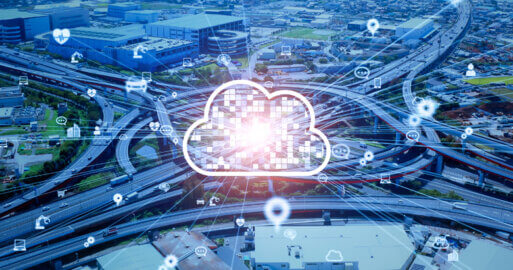What Is Edge Computing and Why Is It Important?

Edge computing is cutting-edge technology that is transforming the way we process data in digitally networked ecosystems. But exactly what is edge computing and why is edge computing important? Edge computing brings processing power closer to the source of data, rather than sending it to a centralized location. As the world becomes more connected and the amount of data generated continues to grow, edge computing is poised to play an increasingly important role in shaping the future of technology. This blog provides an introduction to edge computing, the benefits of edge computing and some examples on industry applications of edge computing.
What is edge computing?
Edge computing refers to the practice of processing data closer to where it is generated, rather than sending it to a central location for processing. This means that data is processed in real time, without the need for a high-speed internet connection. Increasingly, the proliferation of connected, Internet of Things (IoT) devices is why edge computing is important. With so much data being generated by these devices, it’s not practical to send all the data to a central location for processing. Edge computing allows for faster, more efficient processing of data, which in turn can lead to better decision-making and improved performance.
Edge computing works by using mainly small, low-power devices called “edge devices.” These edge devices are located close to data sources and connected to a network, which allows them to communicate with each other and with the cloud. When data is generated, it’s processed by an edge device, which can then send the processed data to the cloud for further analysis. This process is much faster than sending all of the data to the cloud for processing, which can take a long time and require a lot of bandwidth. Edge computing will not replace cloud computing. Rather, edge computing aims to push some of the cloud’s processing power and storage capacity closer to devices that produce and consume the data. Therefore it extends today’s cloud capabilities to a seamless hybrid computing environment.
As we explore the possibilities that edge computing offers the world by bringing data storage and processing power closer to data source devices, one possibility includes multi-access edge computing (MEC). Multi-access edge computing is a specific implementation of edge computing for wireless communication networks, such as 4G or 5G. Multi-access edge computing focuses on deploying edge computing capabilities at base stations or access points, enhancing network performance and delivering low-latency services to wireless communication users. Such implementation concepts, like the MEC for telecommunications, play more and more a significant role in various industries, including healthcare, transportation and smart cities. Thereby it enables new edge-based services and applications, such as video analytics for real-time surveillance, low-latency analytic services or intelligent autonomous logistics.
What are the benefits of edge computing?
One of the biggest benefits of edge computing is its ability to reduce latency. By processing data closer to the source, edge computing can significantly reduce the time it takes to transmit data to the cloud. With edge computing, data is processed locally on devices or servers at the edge of the network, rather than being sent to a central data center for processing. This means that data can be processed in real time, without the latency that comes with sending data back and forth to a central location. This is particularly important for businesses that rely on real-time data analysis, such as those in the healthcare and finance industries, as well as applications that require real-time data processing, such as autonomous vehicles and industrial automation.
Another benefit of edge computing is its ability to enhance security, because sensitive data can be processed and stored locally instead of being sent to a central location where it may be more vulnerable to cyber attacks. By processing data locally, edge computing can reduce the risk of data breaches and cyber attacks.
Additionally, edge computing can help businesses reduce network congestion and bandwidth costs by reducing the amount of data that needs to be transmitted over the network and to the cloud. Edge computing is a powerful technology and a compelling option for businesses looking to improve their data processing capabilities. Take advantage of three key benefits that edge computing offers:
- Latency reduction
- Enhanced security
- Cost savings on bandwidth
Overall, edge computing is a useful technology for optimizing web apps and connected devices by securely minimizing bandwidth usage and latency. With that it has a big impact on both security and sustainability requirements of new IT/OT system landscapes.
Edge computing’s impact on security considerations
When it comes to edge computing, security is an important consideration that cannot be overlooked. As more and more devices are connected to the internet, the risk of cyber attacks increases and the importance of cyber security for businesses cannot be underestimated. Edge computing has the potential to reduce the strain on network infrastructure and improve security by keeping sensitive data closer to the source. Edge computing, which involves processing data closer to the source rather than in a centralized location, can help mitigate some of these risks by reducing the amount of data that needs to be transmitted over the internet.
However, to implement edge computing, it is important to ensure that edge devices and networks are secure through measures such as encryption, access controls and regular software and firmware updates. Additionally, it is important to have a plan in place for responding to security incidents, as well as to regularly test and evaluate the security of edge computing systems. By taking these steps, organizations can harness the powerful benefits of edge computing while minimizing cyber security risks.
Edge computing’s impact on sustainability
Edge computing has the potential to improve sustainability across every industry. By bringing computing resources closer to the data source and processing data at the network edge, edge computing helps reduce the need for transmitting large amounts of data to centralized cloud servers.
Here are a few ways edge computing can be used to improve sustainability:
- Energy efficiency: Edge computing enables localized data processing, reducing the need for long-distance data transfers and minimizing energy consumption during data transmission. This can result in lower carbon emissions and reduced energy usage.
- Reduced latency: By processing data closer to the source, edge computing reduces latency and enables real-time decision-making. This is beneficial for applications like smart grids, autonomous vehicles, and industrial IoT, where real-time responsiveness is critical. Optimized operations and quicker response times can lead to energy savings and improved efficiency.
- Enhanced bandwidth management: Edge computing helps alleviate network congestion and reduces bandwidth demand by processing and storing data locally. This can prevent network bottlenecks and reduce the need for network infrastructure expansion, consequently reducing energy consumption associated with network operations.
- Resource optimization: Edge computing enables distributed computing resources at the edge of the network, allowing for more efficient resource utilization. By leveraging local computing power, edge devices can perform data processing tasks without relying heavily on centralized cloud servers. This reduces the overall demand for cloud resources, resulting in energy savings and improved resource allocation.
- Fewer data privacy concerns: Edge computing allows for data processing and analysis at the edge, which reduces the need to send sensitive data to the cloud. This helps to reduce privacy concerns and compliance issues related to data storage and transmission.
By leveraging edge computing technologies to improve sustainability, organizations can improve operational efficiency and response times. Edge computing enables organizations to contribute to a more sustainable future by reducing energy consumption, optimizing resources and addressing data privacy concerns.
What are the industry applications of edge computing?
Bringing the processing power closer to data sources reduces the need for data to be sent to a centralized location for processing or control. This makes the industry applications of edge computing far-reaching, with the potential to further transform many industries such as automotive, healthcare and manufacturing.
Automotive industry applications of edge computing
In the automotive industry, edge computing is enhancing various aspects of vehicle functionality and enabling innovative applications for faster response times and increased safety.
- Real-time vehicle monitoring: Edge computing enables automotive manufacturers to capture and analyze data from various vehicle sensors in real-time, allowing for proactive maintenance and improved performance. For example, edge devices can process data from engine sensors to identify potential issues and send alerts to drivers or maintenance teams, ensuring timely repairs and avoiding breakdowns.
- Autonomous driving: When an autonomous vehicle drives down a road, it needs to collect and process data about traffic, pedestrians, street signs and stop lights. If the vehicle needs to quickly stop or swerve to avoid an accident, there just isn’t enough time to send data back and forth from the vehicle to the cloud. Edge computing brings cloud computing services closer to a vehicle, enabling the vehicle’s IoT sensors to process the data quickly enough in real time to avoid an accident. An autonomous vehicle can make split-second decisions without relying solely on cloud-based processing.
- Intelligent traffic management: Edge computing can be utilized to analyze traffic patterns and optimize routes in real time. By collecting data from a network of edge devices installed in vehicles or roadside infrastructure, smart algorithms can process and analyze this data locally, providing drivers with real-time traffic information and suggesting alternative routes to avoid congestion and safety hazards. This improves overall traffic flow and reduces travel times for commuters.
Healthcare industry applications of edge computing
Edge computing has several new applications that are transforming the healthcare industry by enabling faster, more efficient and personalized care, including:
- Remote patient monitoring: Edge computing allows for real-time monitoring of patients’ vital signs and health data at edge devices, such as wearable sensors or connected medical devices, so that doctors can respond quickly to any changes in a patient’s condition. This enables healthcare providers to receive timely updates on patients’ conditions and provide immediate interventions if necessary.
- Telemedicine and telehealth: Edge computing can enhance telemedicine services by processing data closer to the source, reducing latency and enabling faster analysis of medical images or video consultations. This enables physicians to provide remote care with minimal delays, improving the patient experience and healthcare outcomes.
- Emergency response systems: Edge computing can support emergency response systems by processing data from wearable devices or smart sensors in real time. This allows for quicker detection of changes in vital signs and quicker response to emergencies.
Manufacturing industry applications of edge computing
By leveraging edge computing, manufacturers can enhance their operational agility, reduce costs and improve the overall efficiency and quality of their manufacturing processes. Three examples of edge computing use cases in the manufacturing industry include:
- Predictive maintenance: Edge computing enables manufacturers to implement real-time monitoring and analysis of machinery and equipment on the factory floor. By deploying edge devices and sensors, data can be collected and processed locally, allowing for quick detection of anomalies and potential failures. This helps manufacturers identify maintenance needs in advance and avoid any costly unplanned downtime, improving overall operational efficiency.
- Quality control and inspection: Edge computing is used to perform real-time analysis of production data to ensure product quality and identify defects or deviations from set standards. High-speed cameras and sensors can capture images or measure parameters at high frequencies, allowing for immediate analysis and decision-making at the edge of the network. This enables manufacturers to intervene rapidly, reducing product waste and ensuring consistent quality.
- Intralogistics optimization: Edge computing can be used to optimize inventory management and material flow. By deploying edge devices in warehouses and distribution centers, real-time data on inventory levels, demand patterns and transportation metrics can be analyzed locally and delivered autonomously to production lines via driverless transportation systems. In this way, manufacturers can improve order fulfillment and increase their ability to adapt and respond.
The possibilities of the industry applications of edge computing are becoming endless, but finally enable manufacturers to make quicker business decisions and enhance overall supply chain responsiveness and product visibility. As this continues to evolve we can expect to see even more exciting edge computing applications in the future. Indeed, the potential of edge computing to enable real-time responsiveness and faster decision-making positions it as a key technology for building smarter digital ecosystems with integrated smart services.
Leverage the power of edge computing through and for integration
Edge computing also challenges integration platform vendors to move their functions closer to the edge. Ensuring data governance when integrating data from multiple sources between edge devices and other endpoints involves several important aspects, including:
- Connectivity: While edge computing devices process data locally, they can also connect to the cloud for additional analysis, storage and collaboration purposes. Integration platforms facilitate the secure and efficient integration of edge and cloud services, enabling hybrid computing environments.
- Integration: Edge devices perform critical data processing tasks, such as real-time analytics, AI inference, or complex event processing. These localized processing functions also require efficient data integration within nodes.
- Monitoring: Edge computing devices collect data from various sources, such as sensors, IoT devices, or on-premises applications. With pre-processed and filtered data, efficient monitoring can ensure data consistency and enable near real-time sharing of insights and information.
As we move toward an even more connected world, edge computing will become more critical for ensuring smooth data flows, integration and synchronization. Already today, SEEBURGER is exploring new technologies and solutions that act as intermediaries for and between the integration of services on edge, fog and cloud systems. This will take business integration for a fully digitalized and connected ecosystem to a new level.
Technical Whitepaper
Download our white paper to learn more about the SEEBURGER BIS Platform.
DownloadThank you for your message
We appreciate your interest in SEEBURGER
Get in contact with us:
Please enter details about your project in the message section so we can direct your inquiry to the right consultant.
Written by: Kim Herman
Kim began her career as a software technical writer, taught English to IT professionals in Hong Kong for two years and then joined SEEBURGER in 2021 as a copywriter. Kim loves the hot Arizona summers and hiking in the desert, especially when the cactus flowers bloom in May.





